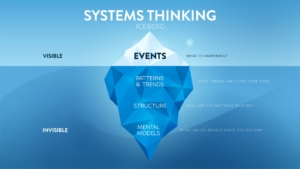Beyond Silos: The Power of Systems Thinking for Business Success
/in Uncategorized

As the business world becomes increasingly complex and interconnected, managers are facing growing challenges in navigating the many interrelated systems within and beyond their organizations. In response to these challenges, many managers are turning to systems thinking – an approach that emphasizes the importance of understanding the dynamic relationships and feedback loops between different elements of a system.
At its core, systems thinking is about seeing the whole picture – not just the individual parts – and recognizing that everything is interconnected. This means that changes in one part of a system can have far-reaching consequences throughout the system as a whole. For example, a decision to cut costs in one department may have unintended consequences on the quality of products or services, or on the morale of employees.
By adopting a systems thinking approach, managers can develop a more nuanced understanding of their organizations and the broader environment in which they operate. They can identify the various feedback loops and interconnections between different parts of the system, and adjust their strategies accordingly to optimize overall performance. This can lead to more efficient processes, improved product and service quality, and enhanced organizational resilience in the face of changing circumstances.
One of the key tools of systems thinking is the use of feedback loops – which are mechanisms that enable a system to monitor and respond to changes in its environment. By monitoring feedback loops within their organizations, managers can gain insights into the causes and effects of different elements, and adjust their strategies accordingly. For example, a company may use customer feedback loops to identify areas where their products or services could be improved, or employee feedback loops to identify ways to improve internal processes and morale.
Another important aspect of systems thinking is the use of mental models – which are the beliefs and assumptions that individuals hold about a particular system. These mental models can shape perceptions and actions, and may need to be challenged or revised in order to develop a more accurate understanding of the system. By challenging and revising mental models, managers can develop a more nuanced and accurate view of their organizations, which can inform more effective decision-making.
Boundary critique is also an important aspect of systems thinking, involving the examination of the boundaries and assumptions that define a system. By examining these boundaries, managers can reveal hidden interconnections and feedback loops, and gain a more comprehensive understanding of the system as a whole.
While systems thinking offers many benefits for organizations, it is not without its challenges and limitations. For example, some critics have argued that systems thinking can be overly reductionist or biased towards certain perspectives, or that it may not be applicable to certain types of systems. Nevertheless, the benefits of systems thinking are clear – by adopting a more holistic and interconnected view of their organizations, managers can develop more effective strategies and solutions to the complex challenges they face.
In conclusion, systems thinking is a powerful approach to navigating the complexities of today’s business landscape. By seeing the whole picture and understanding the dynamic relationships and feedback loops between different elements of a system, managers can gain a more nuanced and accurate view of their organizations, and develop more effective strategies for success. While there may be challenges and limitations to this approach, the benefits of systems thinking are clear – and it is likely to become an increasingly important tool for managers in the years ahead.
True Systems Thinking
/in BlogIn the field of management cybernetics and Lean performance improvement, when problems in operating processes or pain points are detected they are welcomed because they are indications that operating aspects of a process are not seamlessly integrated with the surrounding environment the organization is functioning within. As such, when an operating pain point is detected, it is not frowned upon but cheered because it points to an opportunity to adjust operations to be more in harmony with the external changing environment feeding an operation in the form of information, material and people, aka external energy.

The same principle applies to the individual and the best model to illustrate this is Quantum Psychology. Pain that is experienced in the physical body of a person is connected to the more subtle energy bodies or layers that exists within the person. We now know through the science of acupuncture, holistic medicine and the yogic sciences that these subtle energy layers extent out to our physical operating environment. So similar to the way that we experience pain points in the organization, such physical indications within us signal opportunities to better integrate with the ever-changing flow of the energy surrounding us in our functioning environment. Similar to how we make an internal adjustment within a process to improve the flow of our operating process, resulting not only in an internal change but also an external one, in our personal environment, when we remedy a physical pain experience, it has an internal and external physical and energetic impact on our surroundings. This is True Systems thinking.
Systems Thinking without Boundaries
/in UncategorizedIn the field of management cybernetics and Lean performance improvement, when problems in operating processes or pain points are detected they are welcomed because they are indications that operating aspects of a process are not seamlessly integrated with the surrounding environment the organization is functioning within. As such, when an operating pain point is detected, it is not frowned upon but cheered because it points to an opportunity to adjust operations to be more in harmony with the external changing environment feeding an operation in the form of information, material and people, aka external energy. The same principle applies to the individual and the best model to illustrate this is Quantum Psychology. Pain that is experienced in the physical body of a person is connected to the more subtle energy bodies or layers that exists within the person. We now know through the science of acupuncture, holistic medicine and the yogic sciences that these subtle energy layers extent out to our physical operating environment. So similar to the way that we experience pain points in the organization, such physical indications within us signal opportunities to better integrate with the ever-changing flow of the energy surrounding us in our functioning environment. Similar to how we make an internal adjustment within a process to improve the flow of our operating process, resulting not only in an internal change but also an external one, in our personal environment, when we remedy a physical pain experience, it has an internal and external physical and energetic impact on our surroundings. This is True Systems thinking.
